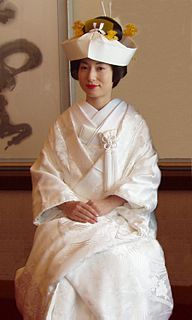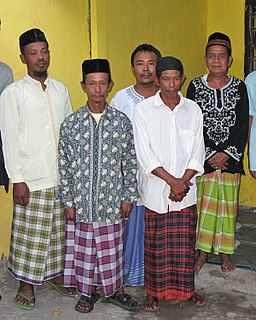
The kimono (着物, きもの) is a traditional Japanese garment. The term means "garment"; ki (着) means "to wear", and mono (物) means "thing" or "object". It has come to mean full-length formal robes. The standard English plural is kimonos, but kimono is also used for the plural form in English as Japanese does not distinguish plural nouns. Kimonos are often worn for important festivals and formal occasions as formal clothing.

A jumper or jumper dress, pinafore dress or informally pinafore is a sleeveless, collarless dress intended to be worn over a blouse, shirt, T-shirt or sweater. Hemlines can be of different lengths and the type of collar and whether or not there is pleating are also variables in the design.

A tallit is a fringed garment traditionally worn by religious Jews. The tallit has special twined and knotted fringes known as tzitzit attached to its four corners. The cloth part is known as the "beged" and is usually made from wool or cotton, although silk is sometimes used for a tallit gadol.

A leotard is a unisex skin-tight one-piece garment that covers the body from the crotch to the shoulder. The garment was first made famous by the French acrobatic performer Jules Léotard (1838–1870). There are sleeveless, short-sleeved and long-sleeved leotards. A variation is the unitard, which also covers the legs.

For the a form-fitting garment which covers the whole body see:Jumpsuit or Onesie

A skirt is the lower part of a dress or gown, covering the person from the waist downwards, or a separate outer garment serving this purpose.

A bodystocking is a one-piece skin-tight garment that covers the torso, legs and sometimes the arms of the wearer. It is a foundation garment or an article of lingerie usually made from a sheer fabric similar to that used for stockings or pantyhose, or from fishnet, lace or an opaque material, or a variation of these materials. A bodystocking differs from a unitard, which is worn as an outfit or article of clothing, and a leotard, which is used as a practice garment or performance costume for acrobats, gymnasts and other similar performers. Designed to be revealed, but not to be too revealing, bodystockings may be worn as undergarments by performers such as belly dancers and exotic dancers.

Vestments are liturgical garments and articles associated primarily with the Christian religion, especially among the Eastern Orthodox, Catholics, Anglicans, and Lutherans. Many other groups also make use of liturgical garments; this was a point of controversy in the Protestant Reformation and sometimes since, in particular during the Ritualist controversies in England in the 19th century.

A temple garment, also referred to as garments, the garment of the holy priesthood, or Mormon underwear, is a type of underwear worn by adherents of the Latter Day Saint movement after they have taken part in the endowment ceremony. Garments are worn both day and night and are required for any adult who previously participated in the endowment ceremony to enter a temple. The undergarments are viewed as a symbolic reminder of the covenants made in temple ceremonies and are seen as a symbolic and/or literal source of protection from the evils of the world.

Nightwear – also called sleepwear, nightclothes, or nightdress – is clothing designed to be worn while sleeping. The style of nightwear worn may vary with the seasons, with warmer styles being worn in colder conditions and vice versa. Some styles or materials are selected to be visually appealing or erotic in addition to their functional purposes.

A sarong or sarung is a large tube or length of fabric, often wrapped around the waist, worn in South Asia, Southeast Asia, the Arabian Peninsula, East Africa, and on many Pacific islands. The fabric often has woven plaid or checkered patterns, or may be brightly colored by means of batik or ikat dyeing. Many modern sarongs have printed designs, often depicting animals or plants. Different types of sarongs are worn in different places in the world, notably, the lungi in India and the izaar in the Arabian Peninsula.

A tunic is a garment for the body, usually simple in style, reaching from the shoulders to a length somewhere between the hips and the ankles. The name derives from the Latin tunica, the basic garment worn by both men and women in Ancient Rome, which in turn was based on earlier Greek garments that covered wearers' waists.

A pea coat is an outer coat, generally of a navy-coloured heavy wool, originally worn by sailors of European and later American navies. Pea coats are characterized by short length, broad lapels, double-breasted fronts, often large wooden, metal or plastic buttons, and vertical or slash pockets. References to the pea jacket appear in American newspapers at least as early as the 1720s, and modern renditions still maintain the original design and composition.

Sherwani is a long coat-like garment worn in the Indian subcontinent, very similar to a British frock coat or a Polish żupan. It was traditionally associated with the Indian subcontinent. It is worn over a kurta with the combination of either a churidar, a dhoti, a pajama, or a shalwar/sirwal as the lower-body clothing. It can be distinguished from the achkan by the fact that it is shorter in length, is often made from heavier suiting fabrics, and by the presence of a lining.

The quechquemitl is a garment which has been worn by certain indigenous ethnicities in Mexico since the pre Hispanic period. It usually consists of two pieces of rectangular cloth, often woven by hand, which is sewn together to form a poncho or shawl like garment, which is usually worn hanging off the shoulders. It can be of various cloths, often with intricate weaves and highly decorated, most often with embroidery. In the pre Hispanic period only women of high social rank could wear it. Since the colonial period, it has been adopted by various peoples, mostly living in central Mexico for everyday wear, festival and rituals, but its use has declined.

Clothing fetishism or garment fetishism is a sexual fetish that revolves around a fixation upon a particular article or type of clothing, a collection of garments that appear as part of a fashion or uniform, or a person dressed in such a garment.
Military personnel of the Roman Republic and Empire wore loosely regulated dress and armour. The contemporary concept of uniforms was not part of Roman culture and there were considerable differences in detail. Armour was not standardized and even that produced in state factories varied according to the province of origin. Likewise the Romans had no concept of obsolescence. Provided it remained serviceable, soldiers were free to use armour handed down by family members, buy armour from soldiers who had completed their service or wear discontinued styles of armour if they preferred it to the latest issue. Thus it was common for legions to wear a mix of various styles that could cover a considerable time period.

Undergarments are items of clothing worn beneath outer clothes, usually in direct contact with the skin, although they may comprise more than a single layer. They serve to keep outer garments from being soiled or damaged by bodily excretions, to lessen the friction of outerwear against the skin, to shape the body, and to provide concealment or support for parts of it. In cold weather, long underwear is sometimes worn to provide additional warmth. Special types of undergarments have religious significance. Some items of clothing are designed as undergarments, while others, such as T-shirts and certain types of shorts, are appropriate both as undergarments and as outer clothing. If made of suitable material or textile, some undergarments can serve as nightwear or swimsuits, and some are intended for sexual attraction or visual appeal.

In the context of clothing, a wrap can refer to a shawl or stole or other fabric wrapped about the upper body, or a simple skirt-type garment made by wrapping a piece of material round the lower body. Many people of both genders throughout the world wear wraps in everyday life, although in the West they are largely worn by women. They are sometimes sewn at the edges to form a tube which keeps the required size. A wrap may be secured by a corner being tucked beneath the wrapped material, by making a knot, or using ties, buttons or velcro.

A cape is a sleeveless outer garment, which drapes the wearer's back, arms and chest, and fastens at the neck.





















